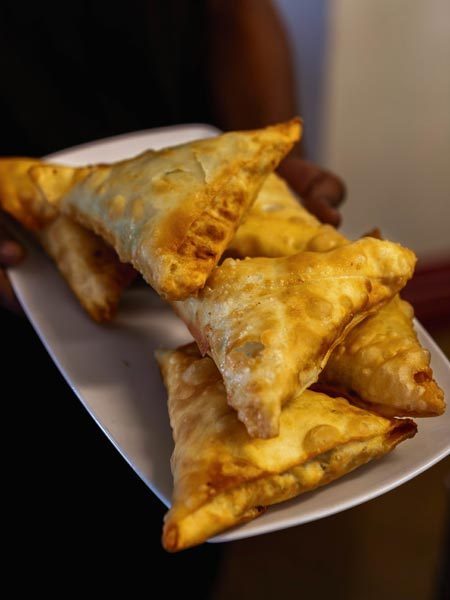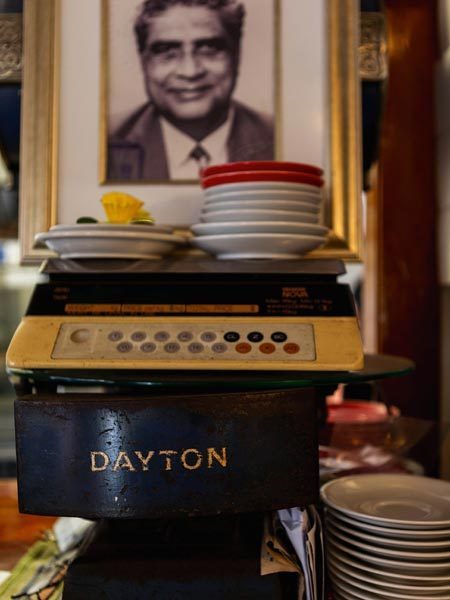TRACY WHITMEY uncovers the story of Rupa’s cafe, a battler that’s still standing despite a turbulent past.
Kids are spilling out of school at the end of the day, and as they wait with Mum to cross the road outside Rupa’s cafe, two small girls are highfiving with cafe owner, Dilip Rupa.
Occupying a prominent corner site on Wellington Street in Auckland’s Freemans Bay, Rupa’s – including the colourful billboard across its upper storey inspired by a historic Bushells tea sign – is firmly rooted in local history. The two-storey wooden building was erected in 1899, with the brick building next door being added in the 1930s. They were bought in 1953 by Dilip Rupa’s parents who opened a general store. Dilip’s family worked hard, building a loyal customer base of locals and the support of their neighbours. And today, Rupa’s is a popular neighbourhood cafe, still attracting many residents and local workers, who pop in for one of Dilip’s signature coffees or chai, for lunch from the cabinet stuffed with samosas, filled rolls, wraps, slices and cakes, or to pick up a frozen curry to take home.
But it takes more than an interesting building and a good location to make a stand-out local cafe, and clearly this is no trendy, here-today-gone-tomorrow pop up. It’s a solid, traditional cafe, the type of which can be found in suburbs across the country. So what is the secret of its longevity? “It’s part of the neighbourhood,” Dilip says, “It’s a place where people feel comfortable, where people come together and everyone is welcome.” Dilip also believes that Rupa’s is respected for its sense of social justice and as an anti-bureaucratic symbol of the refusal to be bullied.
So there’s more to this cafe than you see at first glance – and in fact technically it’s not even a cafe, but still classed as a general store – just as there’s more to Dilip, a vocal political campaigner as well as the genial cafe owner goofing about with the school kids. And the two are inextricably linked. “You don’t want to know about all that stuff,” says Dilip, but tales trickle out over the course of our conversation about the circumstances that have shaped Rupa’s and why it is what it is today.
Going back to the 50s and 60s Auckland City Council decided that the time was ripe to clean up the area and demolish large parts of the neighbourhood. Believing that the school adjacent to the store would grow, Dilip’s parents bought property across the road in case they had to move but were dismayed when this and other properties were bought out by the council. This was the first of many issues between the Rupa family and the council – what Dilip sees as systematic discrimination against the family over many years, stymying their plans and preventing expansion – matters which clearly cut deep. Glancing around the cafe Dilip says ruefully, “This place should be so much better.”
As the area changed, the needs of the community changed, too. Customers wanted a cafe and Dilip wanted to give them the food and the flavours he had grown up with and loved. Eventually, tired of being dictated to by bureaucrats and with the building becoming increasingly dilapidated due to a designation preventing improvements, Dilip decided to take matters into his own hands. He began to renovate bit by bit, without permits, and slowly a cafe emerged from the bosom of the store. Reflecting the bureaucratic buffeting suffered by the family, the building too bears scars of past turmoil: inside there’s a skew-whiff door and a chimney and wall leaning at an angle, legacy of when bulldozers working on the site next door dug up the land adjacent to the shop. Other aspects of the place’s colourful past and Dilip’s varied interests pop up through the interior. One entire wall of the cafe is taken up by the infamous wooden Bushells tea sign; formerly part of the building façade it was removed, restored and is now cleverly reinvented as a sliding door fronting a storage area. A picture of Queen Elizabeth II and Prince Philip hangs alongside a United Tribes of New Zealand flag.
The food, too, reflects elements of the family’s past. Dilip credits his Gujerati ancestors for a deft hand with the spices, as that region was the gateway through which much of India’s spice trade passed on its way out to the world.
Large freezers are stacked with curries made in house to take away, many of them vegan or vegetarian. Dilip is proud of their butter chicken which he says is authentically spiced, without the sweetness that mars many restaurant versions.
Rupa’s famous samosas, rated by Cuisine’s senior food writer, Ginny Grant as the “some of the best samosas in Auckland”, are made to a Gujerati recipe. Fragrantly spiced, bulging with flavours and with pastry hitting the sweet spot between chewy and light, but never greasy, they truly are worth crossing town for.
SEE MORE FROM CUISINE
Pinot getting better & better
There’s no holding back New Zealand pinot noir with some sensational…














